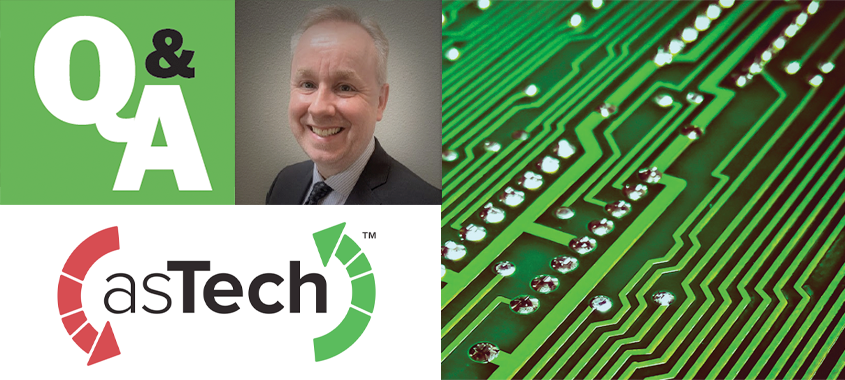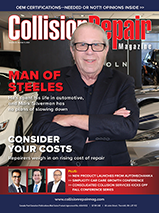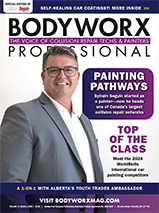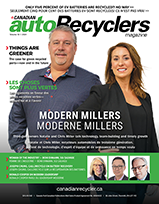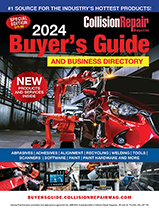THE ASTECH APPROACH
REPAIRIFY (ASTECH) PRESIDENT CRIS HOLLINGSWORTH ON WHAT’S AHEAD
By Max Reid
Whether it be as rudimentary as a backup camera or tire pressure gauges, or as complicated as a fully self-driving platform, ADAS components can be found in nearly every vehicle on the road today, and they aren’t getting any less complicated.
Companies like asTech help provide shops with the tools and documentation to stay current with the always-changing world of advanced driver-assistance systems. Through asTech’s acquisition of adasThink, and the more recent investment from 3M, the company’s reach is extended further than ever, to help get shops prepared for these new components.
That is why Collision Repair got a hold of Cris Hollingsworth, president of Repairify, asTech’s parent company, to talk about the future landscape for collision repairers in an increasingly ADAS-heavy world.
Collision Repair: With the widespread use of ADAS technology becoming more prevalent and an overall decrease in collisions expected to result from that, how do you expect the business landscape for collision shops to change?
Cris Hollingsworth: If that does happen, we know it’s important to help empower the shops and our business partners to be prepared for the sophistication of the vehicles. Our company recently acquired adasThink; we’re very pleased with that because of the additional services that we can provide to our customers. The data is validating that 80-plus percent of vehicles today require one or more calibrations. What we see is that with the growing sophistication of and complexity of parts, shops will be evolving; this will be both a challenge and an opportunity for shops. It is a challenge to make certain that they stay current with the right tools, technology and equipment in order to do those calibrations. It is not simple to do a calibration. Today, it involves exterior components, like targets or alignment systems, or even just having a level floor.
CR: What proportion of collision shops today do you believe are currently capable of ADAS calibrations?
CH: asTech has internal data and we look at it constantly to determine exactly how many of our customers are capable of doing certain kinds of calibrations. The challenge is that calibrations have become so widespread and deep that shops have different capability levels. There are facilities capable of doing 50 percent of the calibrations that are present on vehicles today, and there are shops that can do 100 percent of them. It’s not something you can put a percentage on. What is most important here is the fact that we see the way that we can help the industry. There’s going to be more calibrations in the future and shops need to be prepared to do them. At asTech, we’re simply trying to provide the tools and equipment for them to be able to get back to really what is the core objective, which is to fix the vehicle properly and return it to its OE operating conditions.
CR: How can the products and services that asTech provides help shops in their dealings with insurers?
CH: We’re focused on accuracy and complete quality repair. Going back to the adasThink acquisition; what we see as the first and foremost thing is to help the shop to properly identify the ADAS systems that are in a vehicle. That is what we are accomplishing with that kind of data product.
The second piece then, is to make certain that we enable shops, through our course solutions—to make certain that we provide them with documentation, so that they are doing repairs to the OEM standards.
At the same time, we provide the reports and the documentation to support the reimbursement for the shop with the [insurance] carriers and through the DRP programs, so that the carriers are comfortable in the fact that the shop has identified the systems that are in the car and the shop did use the appropriate tool. The carrier can effectively look at the file and say, ‘I can see here the shop actually referenced OE documentation on how to do that calibration.’ We provide all of that to our shops. We see it as a sort of total service solution.

CR: Could you talk a little bit about the relationship between OEM certification and ADAS technology?
CH: The industry is becoming more aware that vehicles today are incredibly sophisticated. I like to refer to the fact that vehicles are becoming a platform for a link of networked computers. ADAS technology is focused on the safety and service of the vehicle; and with so much more ADAS technology being installed and implemented as it continues to evolve forward.
Really getting down to making certain that you repair those systems—especially the integrated, networked systems they have become today—repairing them to OEM standards has really become critical, especially to our shop partners. Their goal is to return the vehicle to the appropriate working standard for the customer and following the OE repair process. In the past, you were driving a highly mechanical device. You had mechanical parts that were physically interfacing with each other, in order to make the vehicle operate. Today, you’re actually driving a sophisticated network ecosystem of computer technology.
CR: What do you see as being the most significant safety concern that ADAS will have to address in the near future?
CH: ADAS is definitely about safety, but ADAS is also about service. When people say ADAS, that term is specifically about safety, but the two are almost becoming merged. A lot of the systems on the vehicle are not necessarily a ‘safety’ system. A lot of the systems that have become really automated are also about service, like automatic tire pressure gauges.
The industry has an opportunity. There is a tremendous amount of data able to be aggregated around what is happening in collision events with the ADAS systems that are on vehicles today, based upon the behaviour of the driver; how did that ADAS system work properly, and how did it fail. We have automotive intelligence that we are working to bring to market and be able to help that industry with that data and be able to say ‘based on how the scans and calibrations were done, this is what happens most times this vehicle is in a collision.’ From that data we can extrapolate things like an ADAS system that is not behaving the way that the driver is behaving.
Through that type of collaborative process in the industry, the data will tell us where the industry needs to make those changes. Let the data speak. The data will tell us exactly where ADAS systems are working and where they’re not.




